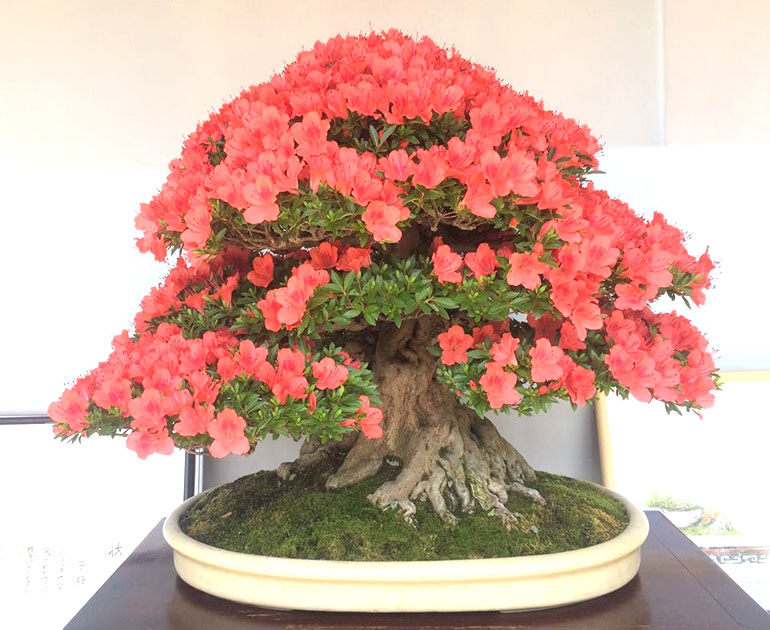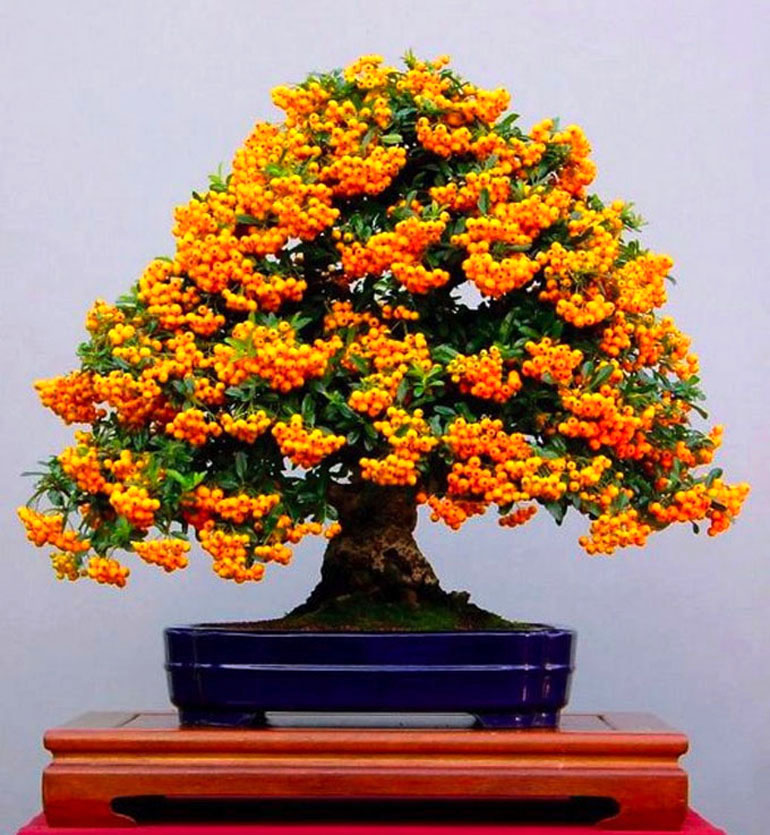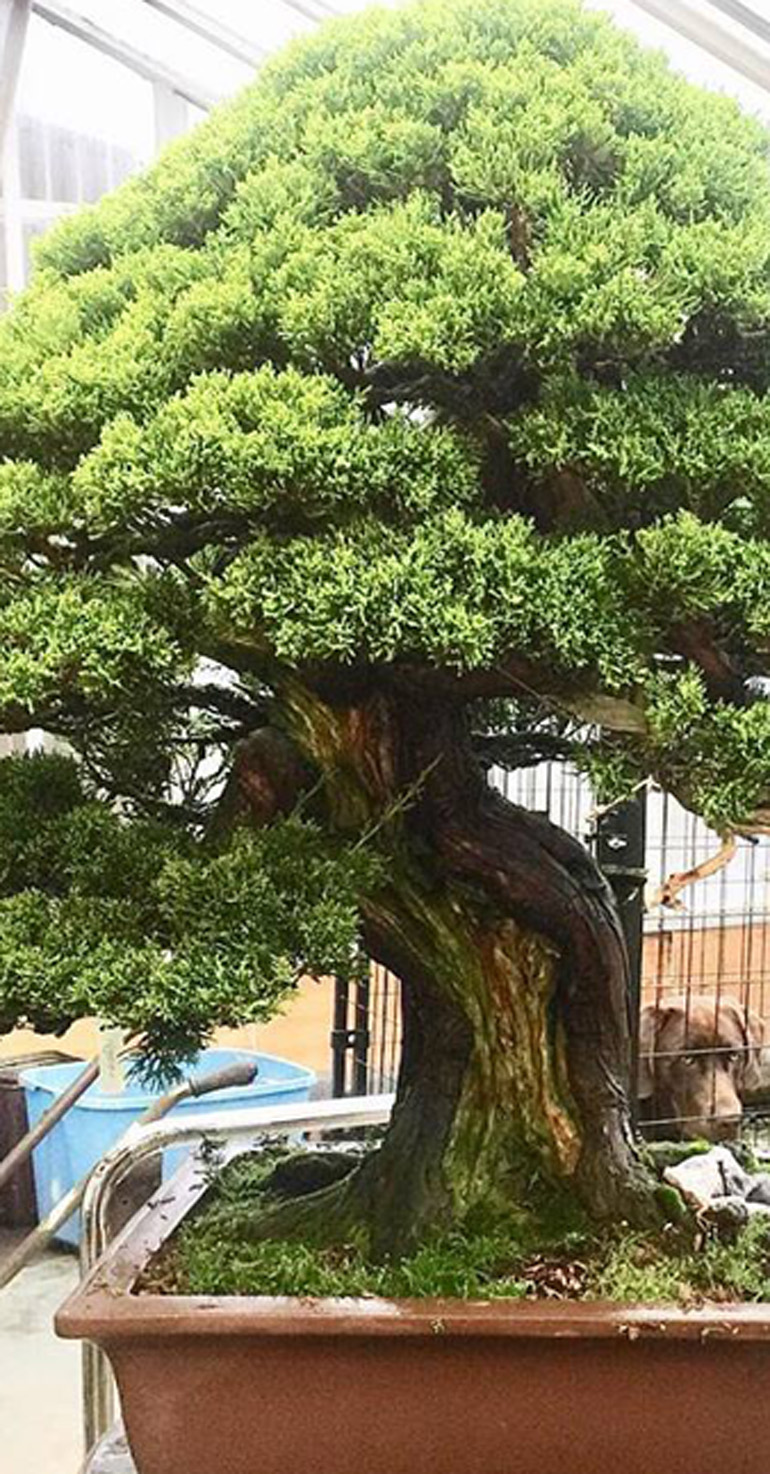“These Bonsai Look Like They Were Made of Plastic”

This Scot's pine (Pinus sylvestris) is from the cover of Bonsai Today issue 104. It belongs to (or belonged to?) Walter Pall. He presented it as an example of a naturalistic bonsai
Walter Pall yesterday, Walter Pall today. This one happens to be our first Walter post ever (June, 2009). It was titled The Great Debate part 2: You Be the Judge. I’ve condensed it to accommodate our shorter attention spans
The following quote by Walter is from the same 2009 post (it originally appeared in Bonsai Today issue 104)… “I have seen that the trend in styling is toward more and more refinement, which often takes away all the naturalness. I find that too many of these bonsai look like they are made of plastic and are not real.”
Continued below…

This is a page from our Juniper book (due back in print in April). It features a famous Needle juniper that belongs to (belonged to?) Shinji Suzuki. To my eye it represents the more stylized look that Walter is objecting to (I'm not taking sides, just reporting). The California juniper in the upper corner was collected and styled by Harry Hirao, "Mr. California Juniper."

At the far end of the spectrum. This wild looking Big cone Douglas fir (Pseudotsuga macrocarpa) belongs to Dan Robinson, aka the Picasso of bonsai. Here's what Dan has to say about it on the Elandan Gardens website: "Collected from natural granitic basin high in the Colorado Rockies, this tree, with the helping hand of Larry Jackall, was lifted straight up out of the basin using a crowbar under the bottom branch. The tree was subsequently planted in a granite basin here at Elandan Gardens. Its spiraled bark and dead wood are the result of a genetic mutation."
Continued from above…
Here’s another quote from Walter… “A traditional bonsai is ideal; it is abstract. A naturalistic bonsai is realistic, but never totally realistic. There’s always a certain degree of abstraction.” If you are interested in more, here’s our first post on the topic.
One Famous Bonsai Artist, One Tree & One T-Shirt

I love this tree with its gently flushed little apples (crabapples), its muscular trunk, subtle movement, gradual taper and well-aged bark. I even love its handlebar branches.*
Today it’s The Venerable** Walter Pall, famous bonsai artist, entertainer and entrepreneur. We’ll keep it short and sweet with just one tree and one photo of the man himself (the tree is worth a whole post to itself and needless to say, the same goes for Walter)
–

Walter in his American Bonsai T-shirt
*Thanks to joakimthoresen
**If you’re really good at something and you live long enough, you might become The Venerable…. (insert your name here)
Bonsai Display Stands & their Trees
Here's David Knittle's caption for this remarkable display: "Honduras rosewood table, 20" x 8.5" x 4" high. It was built for this juniper rock planting displayed at the San Diego Bonsai Club's Fall 2016 show."
Still wrapping up year end stuff, so we’ll take the easy way out and show you one from our archives (Feb, 2017). It’s a good follow up to yesterday’s post on David Knittle’s stands and some of the bonsai that have been displayed on them. All these photos show here (and yesterday) are from David’s fb timeline. There’s a lot more where these came from
Here's David's caption for this one (all the captions in italics are his): "Walnut moon stand - 24" x 24" x 6" deep. The Trident maple and Black pine are from the Goldstein Collection"
"Rosewood table 14" x 9" x 10" high. Cary Sullivan's potato vine bonsai exhibited at the 2015 GSBF Convention"
"Two tiered stand I built using wenge, a wood from Africa. 30" x 8.5" x 18" high. Black pine displayed by Louise Leister at the Artisans Cup. Beautiful tree and display Louise."

No caption with this one. I'm usually loath to guess (for good reason, I'm often wrong) but can't help thinking this remarkable tree is a Chinese elm.

No caption with this one either and like the one above, Chinese elm seems right. But before you take it to the bank, don't forget it's just a guess.

David Knittle at work in his impeccably organized wood shop
Quality Bonsai Deserves Quality Stands

Closeup of a Japanese black pine (Pinus thunbergii) that was exhibited by John Kirby at the 2018 National Bonsai Exhibition. The display table was built by David Knittle (details are below with the uncropped photo)
Flashing back to the 2018 6th National Bonsai Exhibition, here are a couple trees from the Exhibition that we haven’t shown yet, and one other tree that was shown at the 2018 Mid Atlantic Bonsai Festival. All three are on display tables that were built by David Knittle.
–
Olive (Olea europaea) bonsai by Frank Cucchiara that was displayed at the 2018 National Bonsai Exhibition. The Bolivian rosewood octagonal table was built by David Knittle. The top is 14" point to point x 22" high (35.5cm x 56cm)
This Spindle style table by David Knittle was built to be in the National Exhibition. However the tree suffered a misfortune and could not be shown so the stand is available. You can contact David if you're interested. It's made of African rosewood - a very hard, stable wood, dark brown with a reddish undertone. 25" x 18" x 7" (63.5cm x 46cm x 18cm)
Japanese white pine (Pinus parviflora var Kokone) in a Haramatsu-Tosui container and on a perfectly matched rosewood table by David Knittle. The photo is from the 2018 Mid Atlantic Bonsai Festival, where the tree was awarded the Best in Show, People's Choice & the American Bonsai Society's award. The tree is 80 plus years old and has been in training for about 75 years. John has owned and trained it for about ten years. The dimensions of the table are 30" x 20" x 5" high (76cm x 51cm x 12.7cm)
An uncropped photo (see the photo at the top of the post) of John Kirby's Japanese black pine on rosewood table that was built by David Knittle using Nicaraguan rosewood (Dalbergia turcurensis). Dimension are 30" x 22" x 5.5" high (76cm x 56cm x 14cm)
Bonsai Brilliance at Japan’s Satsuki Azalea Festival

This Satsuki azalea with its powerful trunk and nebari would be a remarkable even without its brilliant flowers
The bonsai featured here are from the 2018 Satsuki Azalea Festival in Ueno, Tokyo (even though they are from last year, this is the first time we’ve shown them). You can see these and more flowering Satsuki on Naoi Kenichi’s fb timeline.

Here’s something from Wikipedia on Satsuki azaleas…
“Satsuki azaleas have a diverse rnge of flower forms and color patterns with multiple patterns often appearing on a single plant. Satsuki bloom from May to June; the name “Satsuki” in Japanese is reference to their blooming period, the fifth month of the Asian lunar calendar. They are commonly used as a subject in bonsai and many bonsai enthusiasts and shows are dedicated solely to them. There are thousands of different varieties, but some popular ones are chinzan, kaho, gyoten, osakasuki, eikan, nikko, hakurei, hakurin, kinsai, and many more.”



New Year New Day New Bonsai Essentials
There's something about Quince flowers... Here's Bill Valavanis' caption: "A small size Toyo Nishiki Japanese flowering quince, Chaenomeles speciosa ‘Toyo Nishiki’ with multiple colored flowers. Although red, pink and white blossoms are common for this great cultivar, I’ve often seen red branches grafted onto specimens to improve color distribution."
Welcome to 2019. My other New Year’s resolution (see yesterday) is to avoid recycling these same trees for a forth time next year. Stay posted to see how we do. I guess a passable excuse is just how good these trees are. They’re from the 2015 Kokufu Bonsai Exhibiton and were lifted directly from Bill Valanis’ blog, Welcome To My Bonsai World.
Continued below…–
I've got a soft spot for short muscular trees. Especially short muscular trees whose scarred bark and hunched stance tell a story of hard times and harsh conditions, while lush foliage and vibrant strength tell a story of better times and full recovery. Japanese white pine (Pinus parviflora).

Another Quince ("Chinese quince, Pseudocydonia sinensis, created from air layering the top off another bonsai"). No flowers this time, bit plenty of action nevertheless. At the risk of stating the obvious, you might notice the exfoliating bark. Not to mention that wonderful old pot.

We could have titled this post Quince and Kokufu. Like the tree just above it's a Pseudocydonia sinensis.

Not a quince, but a Japanese grey-bark elm (Zelkova serrata).

You might get the impression that Kokufu is mostly about deciduous bonsai, but I don't think that's really the case (though winter is a great time show off these bare branched beauties). This one with its massive nebari could only be a maple.
Bonsai Berries & a Failed New Year’s Resolution

This prolific Pyracantha was our 2018 New Year's tree. I don't know who the artist or owner is (more about this below), but my guess is the tree is Japanese
Here’s my New Year’s resolution from 2018… No more unattributed trees on this blog (uh… except for the one just above).
So I failed on the first day last year and the failure reoccured throughout the year (you can take this as a metaphor if you’d like). In light of this, here’s a more realistic resolution for this year… I will attribute the trees we post when possible and encourage all of us who have been remiss, to make an effort to do the same*
–

From the many to the few. It's another Pyracantha. It belongs to Shohin master Haruyosi.
Nepal Firethorn (Pyracantha crenulata), in training since 1966, donated to the National Bonsai & Penjing Museum by Yee-Sun Wu.

Flowers come first, so maybe we should have started with this sweet little Bonsai Mike Pyracantha that we originally featured way back in 2010.
*the fine print… sometimes we come across unattributed trees that are too good to pass up. These are often cases where language or other issues make research difficult if not impossible.
Bonsai on a Man Made Rock from Scratch
Before and after planting on a man made 'rock' by Marc Noelanders. No mention is made of the type tree or what the rock is made of. Still, the result is impressive and the photographic progression with the shaping of the rock is an added plus
We’ve shown a number of bonsai on synthetic rocks over the years. Mostly by Kimura, a pioneer in this medium (and other bonsai media as well). But this time it’s Marc Noelanders, a Western bonsai pioneer. What you often see with this type planting is the finished product, but this time we get a peek into the development of the rock rather than just the result
–

First comes the thought, then the sketch (lower right) and then the construction begins

A saw is used to establish the basic shape

Sculpted! Pretty impressive. No mention is made of the tool (or tools) used to create the holes, crevices and final texturing

A masterpiece!. It you would like to explore further and learn what was used to color the rock, how the rock is anchored in the pot, the type tree (looks like the could be fir) and other details, you could try contacting Marc (or there's always Youtube)

Cropped for a closer look at the rock, the foliage and the finishing touches on the soil surface
Bougainvillea Bonsai, Before & After

Bougainvillea, before and after. Now you know how Suthin gets those thick trunks on such small bonsai... hint, he cuts older larger plants way back (obviously, there's more to it than just that, but you have to start somewhere). This works best with tropicals that can handle the stress and have no problem putting out new buds
Continuing with Suthin Sukosolvisit’s bonsai (see yesterday’s post). I borrowed these photos from a post we did on some of Suthin’s tropicals back in March 2015 (with some doctoring and rearranging today). To enjoy more of what Suthin is up to, you can visit him on facebook and his website.

Before. Could this be the same Bougainvillea as the one below?
After. This Bougainvillea is an impressive little tree with or without flowers. Still, it would be nice to see it in full bloom, We'll keep our eyes open and let you know

Closeup of the trunk and a peek into the hole in the center of the foliage

Suthin may be best known for his Shohin bonsai displays. This photo is also from Suthin's website. It was taken by Joe Noga
Happy Root-Over-Rock Bonsai Holidays

Suthin's "Happy Holidays to all" tree. It's a Trident maple root-over-rock (root devouring rock).
Staying close to home today, it’s our old friend Suthin Sukosolvisit offering some bonsai wizardry just in time for the New Year.
–

Cropped for a closer look at how the trunk is slowly devouring the rock

Suthin's caption says simply... "New home" You might recognize this as the tree that won Best Bonsai at the 6th U.S. National. It's a Japanese black pine

Cropped for a closer look at the trunk and pot

“Sayonara!!!”

Does this trunk look familiar?

